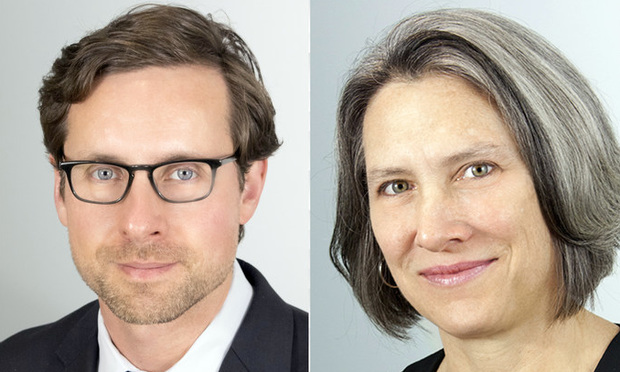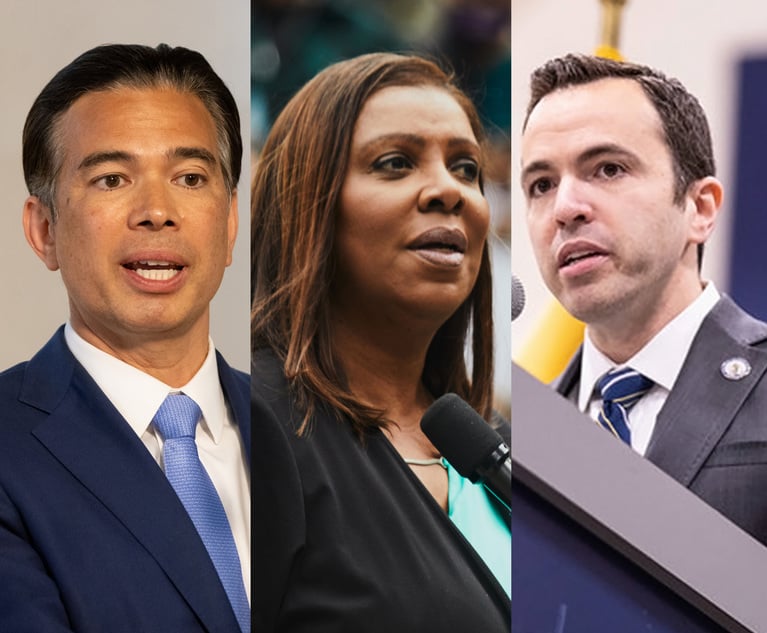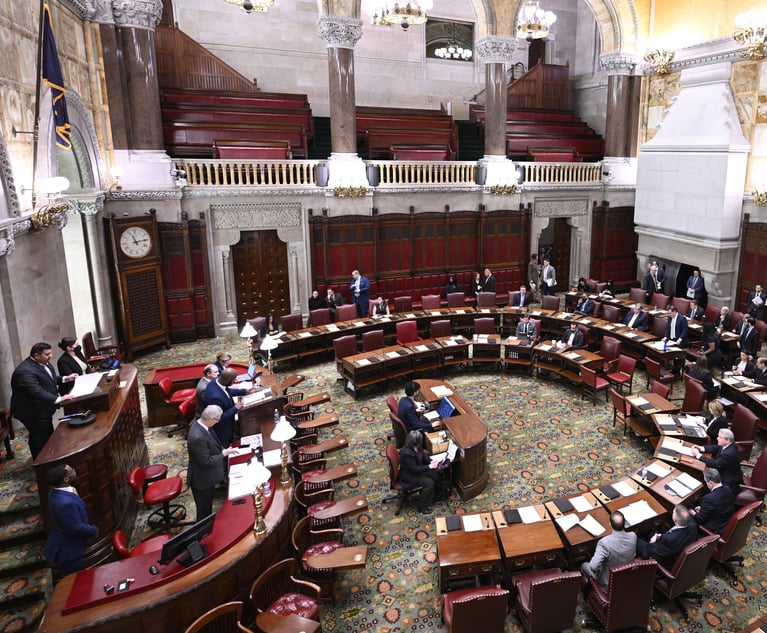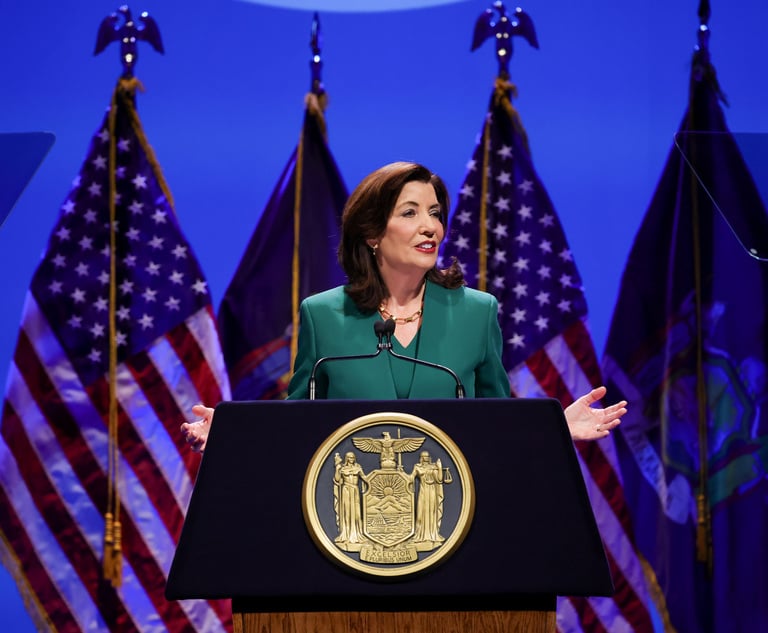State and City Climate Councils Can Learn Some Environmental Lessons from Pause New York
In their Environmental Law column, Karen Meara and Christopher Rizzo explain that environmental advocates and lawmakers have an opportunity to glean some important lessons from the pandemic before they are lost to our rapidly changing news cycle.
June 26, 2020 at 02:45 PM
8 minute read
 Christopher Rizzo and Karen Meara, Carter Ledyard & Millburn.
Christopher Rizzo and Karen Meara, Carter Ledyard & Millburn.
The closures implemented by nations, states and cities to contain the spread of COVID-19 had some unintended environmental benefits.They dramatically reduced air pollution emissions, moderately reduced energy consumption and improved the quality of life for a lot of wildlife. But these benefits are already proving to be short-lived as economies quickly re-open. The pandemic also highlighted how environmental burdens such as poor air quality and lack of open space disproportionately impact low-income communities, often communities of color, and contribute to higher mortality rates.
Environmental advocates and lawmakers have an opportunity to glean some important lessons from the pandemic before they are lost to our rapidly changing news cycle. This article highlights lessons relating to carbon emissions, air quality, energy use and access to open space, and considers how they can inform New York's current and future efforts to achieve environmental goals. It also addresses the fiscal realities of this unique moment and argues that a green New Deal will be key to achieving ambitious goals.
Carbon Emissions
On March 3, just as COVID-19 was on the brink of bringing business as usual to a screeching halt, the New York State Climate Action Council held its inaugural meeting. The Council—24 state appointees lead by the Commissioners of the Department of Environmental Conservation and the NYS Energy Research and Development Agency—is tasked with the hard work of crafting a roadmap to achieve the dramatic carbon emissions reductions required by the state's 2019 Climate Leadership and Community Protection Act. The Act requires a 40% reduction in carbon emissions (over 1990 levels) by 2040 and an 85% reduction by 2050. During the March 3rd meeting, data was presented indicating that the top four sources of carbon emissions in NY are vehicles (36%), buildings (30%), electricity (15%) and garbage (8%). Potential pathways to decarbonization were also listed: electrification of cars and heating, deep penetration of renewables (wind and solar), waste diversion (organics and embedded emissions), conversion of refrigerants, and deep energy efficiency improvements in all sectors. While each of these potential pathways will necessarily play an important role in the final roadmap, the nationwide closures highlighted another pathway to be explored: working from home and reducing travel.
During the height of the closures this spring, millions of "non-essential" employees, primarily office workers, began working from home. Travel plans for business and leisure were cancelled or postponed indefinitely. With this significant reduction in travel by car and plane, carbon dioxide emissions dropped 17% in the United States in March 2020. This annual drop will likely be about half that level but still consistent with the 7.5% annual drop that the U.N. has determined is required to stem the worst impacts of climate change.
Many employers and employees were surprised to find they were able to carry on their work remotely and without extensive travel. This unplanned experiment demonstrated that policies to encourage working from home where feasible for both employers and employees could have a meaningful role to play in reducing the carbon emissions (not to mention air pollution and traffic) associated with commuting by car and should be added to the list of "pathways" considered by the State's Climate Action Council. Moreover, policies to encourage more travel and tourism close-to-home can reduce emissions while supporting local economies.
While the unintended side effects of the COVID-19 closures reduced emissions from commuting and air travel, it may have raised emissions from organic waste: faced with major budget shortfalls, New York City discontinued residential collection of organic waste, 31% of the residential waste stream and a major source of greenhouse gas emissions, for an estimated savings of $21 million in Fiscal Year 2021. The City's decision to cancel collection and diversion of organic waste to biogas and composting facilities at the same time that the State Climate Action Council is counting on such policies to help the State achieve its carbon reduction goals highlights the risks COVID-19 related fiscal woes presents to policymakers. While working from home can be done by many without substantial cost to government, many of the potential pathways to carbon reductions require substantial upfront investments in everything from a network of electric vehicle charging stations, to transmission lines for renewable energy to intensive waste collection and reduction. Although the State has proposed a $3 billion "Restoring Mother Nature" bond act to dedicate to a variety of environmental initiatives, the State and City budget shortfalls are estimated to be three times that sum in 2020 alone. Federal investment in environmental initiatives is therefore essential.
Air Quality
Like many crises, the COVID-19 crisis has hit low-income New Yorkers, including a disproportionate number of people of color, harder than others. While there are many factors contributing to these disparities, and most are beyond the scope of this article, a potentially important one is poor indoor and outdoor air quality. Many lower-income New Yorkers live near congested roadways without benefit of a controlled/filtered indoor air environment and are thus exposed to the many lung irritants contained in car and truck exhaust, like nitrous oxide and particulate matter. They therefore suffer disproportionately from asthma and other respiratory conditions. Because COVID-19 is primarily a respiratory disease, underlying respiratory issues puts these New Yorkers at higher risk of experiencing COVID-19's worst effects, and indeed, data shows that African American and Hispanic New Yorkers have had higher mortality rates than white New Yorkers.
While New York has come a long way from the smog of the 70′s, the COVID-19 crisis has highlighted that there is still work to do to ensure that every New Yorker has clean air to breathe. In 2014-2016, for example, four times as many residents of the Bronx died from asthma as those living in nearby suburbs. As New York considers its options for reducing carbon emissions, it should consider options for incentivizing not only electrification of cars, but also trucks, which contribute disproportionately to pollutants with negative health effects. New York City might also consider accounting for truck emissions in its congestion pricing scheme, though this might run into constitutional issues as courts have held that Congress has preempted state regulation of fuel efficiency and vehicle emissions. Finally, efforts to make buildings more energy efficient should weigh options for improving indoor air; for example, passive houses not only reduce energy use dramatically but also remove allergens and pollution from indoor air.
Energy
The COVID-19 closures reduced not only carbon emissions but also electricity use; the U.S. Energy Information Administration estimates that electricity consumption in most states like New York has dropped about 9-13%. While this is not trivial, it is surprising that the closures didn't produce greater reductions. In some states like Florida there has been little change due to heavy reliance on cooling systems even for empty office buildings. Reductions have not been greater because in many cities, office buildings continued to operate HVAC systems and leave the lights on. If the dramatic changes in human behavior caused by the COVID-19 closures did not dramatically reduce energy demand, cities need to rethink how buildings operate. This likely means moving quickly to power homes and offices with renewable energy and building the transmission system to transport that energy. It also means converting from oil and gas-fired boilers to electric ones, which will come at great cost to home and building owners. Large building owners in New York City will already need to realize these two changes in order to comply with the City's 2019 Climate Mobilization Act, which requires modest reductions in greenhouse gas emissions from buildings of 25,000 square feet or more in 2024 and dramatic reductions in 2030.
Outdoor Spaces
Access to quality parks and public open space has never been more important than during COVID-19 closures. Moreover, the lack of access to quality parks in lower-income communities has never been more glaring. This issue is most acute in New York City and the other urban communities in the State.
New York City has an official goal of having 85% of its residents live within walking distance of a park by 2050. The City's One NYC 2050 plan released in 2019 claims that 81% already meet that standard. But in fact many of those New Yorkers live near parks that provide limited recreational value. For example, Tompkins Square Park in the City's East Village is a lovely square with refurbished plantings but its lawns and gardens are mostly fenced off to visitors. To really provide access to recreational spaces for sports, socially-distanced gatherings and exercise, the City will need to consider making permanent the temporary, pandemic street closures.
While the lessons of the COVID-19 closures will not solve the State's environmental challenges, they add to the toolbox available for achieving the State's decarbonization goals, and underscore the urgency of solving intractable problems like poor air quality. As this article went to press, the Climate Action Council held its second meeting. Among the many important topics the Council discussed were these very issues. We look forward to following the Council's deliberations and weighing in on proposed solutions.
Karen Meara and Christopher Rizzo are attorneys in the environmental and land use group of Carter Ledyard & Milburn.
This content has been archived. It is available through our partners, LexisNexis® and Bloomberg Law.
To view this content, please continue to their sites.
Not a Lexis Subscriber?
Subscribe Now
Not a Bloomberg Law Subscriber?
Subscribe Now
NOT FOR REPRINT
© 2025 ALM Global, LLC, All Rights Reserved. Request academic re-use from www.copyright.com. All other uses, submit a request to [email protected]. For more information visit Asset & Logo Licensing.
You Might Like
View All

Federal Judge Pauses Trump Funding Freeze as Democratic AGs Plan Suit
4 minute read
Relaxing Penalties on Discovery Noncompliance Allows Criminal Cases to Get Decided on Merit
5 minute read
Bipartisan Lawmakers to Hochul Urge Greater Student Loan Forgiveness for Public-Interest Lawyers
Law Firms Mentioned
Trending Stories
Who Got The Work
J. Brugh Lower of Gibbons has entered an appearance for industrial equipment supplier Devco Corporation in a pending trademark infringement lawsuit. The suit, accusing the defendant of selling knock-off Graco products, was filed Dec. 18 in New Jersey District Court by Rivkin Radler on behalf of Graco Inc. and Graco Minnesota. The case, assigned to U.S. District Judge Zahid N. Quraishi, is 3:24-cv-11294, Graco Inc. et al v. Devco Corporation.
Who Got The Work
Rebecca Maller-Stein and Kent A. Yalowitz of Arnold & Porter Kaye Scholer have entered their appearances for Hanaco Venture Capital and its executives, Lior Prosor and David Frankel, in a pending securities lawsuit. The action, filed on Dec. 24 in New York Southern District Court by Zell, Aron & Co. on behalf of Goldeneye Advisors, accuses the defendants of negligently and fraudulently managing the plaintiff's $1 million investment. The case, assigned to U.S. District Judge Vernon S. Broderick, is 1:24-cv-09918, Goldeneye Advisors, LLC v. Hanaco Venture Capital, Ltd. et al.
Who Got The Work
Attorneys from A&O Shearman has stepped in as defense counsel for Toronto-Dominion Bank and other defendants in a pending securities class action. The suit, filed Dec. 11 in New York Southern District Court by Bleichmar Fonti & Auld, accuses the defendants of concealing the bank's 'pervasive' deficiencies in regards to its compliance with the Bank Secrecy Act and the quality of its anti-money laundering controls. The case, assigned to U.S. District Judge Arun Subramanian, is 1:24-cv-09445, Gonzalez v. The Toronto-Dominion Bank et al.
Who Got The Work
Crown Castle International, a Pennsylvania company providing shared communications infrastructure, has turned to Luke D. Wolf of Gordon Rees Scully Mansukhani to fend off a pending breach-of-contract lawsuit. The court action, filed Nov. 25 in Michigan Eastern District Court by Hooper Hathaway PC on behalf of The Town Residences LLC, accuses Crown Castle of failing to transfer approximately $30,000 in utility payments from T-Mobile in breach of a roof-top lease and assignment agreement. The case, assigned to U.S. District Judge Susan K. Declercq, is 2:24-cv-13131, The Town Residences LLC v. T-Mobile US, Inc. et al.
Who Got The Work
Wilfred P. Coronato and Daniel M. Schwartz of McCarter & English have stepped in as defense counsel to Electrolux Home Products Inc. in a pending product liability lawsuit. The court action, filed Nov. 26 in New York Eastern District Court by Poulos Lopiccolo PC and Nagel Rice LLP on behalf of David Stern, alleges that the defendant's refrigerators’ drawers and shelving repeatedly break and fall apart within months after purchase. The case, assigned to U.S. District Judge Joan M. Azrack, is 2:24-cv-08204, Stern v. Electrolux Home Products, Inc.
Featured Firms
Law Offices of Gary Martin Hays & Associates, P.C.
(470) 294-1674
Law Offices of Mark E. Salomone
(857) 444-6468
Smith & Hassler
(713) 739-1250






